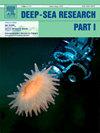High genetic connectivity of the two main cold-water scleractinian framework engineers from the Southwestern Atlantic
IF 2.1
3区 地球科学
Q2 OCEANOGRAPHY
Deep-Sea Research Part I-Oceanographic Research Papers
Pub Date : 2025-10-16
DOI:10.1016/j.dsr.2025.104606
引用次数: 0
Abstract
Cold-water coral reefs (>150 m) are highly biodiverse ecosystems mainly engineered by few scleractinian and Porifera species. Due to the low number of framework building scleractinian species combined with their low growth rates, cold-water reefs are considered vulnerable marine ecosystems susceptible to human impacts such as demersal fisheries. Apart from their occurrence, a seminal information that subsidizes best practices for their conservation is related to gene flow/population genetics. However, research on the latter is hampered by the expensive sampling logistics and, to date, most studies have focused on the North Atlantic. Here we use microsatellite markers to understand the genetic diversity and population structure of the most important cold-water framework builders in the Southwestern Atlantic, Desmophyllum pertusum and Solenosmilia variabilis. The genotyping of 285 specimens belonging to both species showed low clonality rates, high levels of genetic diversity with no evidence of inbreeding, and no population structure along a latitudinal gradient of nearly 700 km, similar to what has been previously observed for the sympatric species Madrepora oculata and M. piresae. The recurrent absence of population structure for cold-water corals in the Southwestern Atlantic along latitudinal and depth ranges, suggests that oceanographic factors, such as the direction and speed of the Western South Atlantic Central Water and of the Antarctic Intermediate Water, combined with the spawning "window" and the pelagic larval duration (PLD) of these species play crucial roles in their dispersion and connectivity patterns.
来自西南大西洋的两种主要的冷水硬核框架工程师的高遗传连通性
冷水珊瑚礁(水深150米)是一种高度生物多样性的生态系统,主要由少数硬核虫和多孔虫组成。由于构建框架的硬核物种数量少,加上它们的生长速度低,冷水珊瑚礁被认为是脆弱的海洋生态系统,容易受到人类的影响,如底栖渔业。除了它们的发生之外,与基因流动/群体遗传学有关的一个重要信息补贴了它们保护的最佳实践。然而,对后者的研究受到昂贵的采样物流的阻碍,迄今为止,大多数研究都集中在北大西洋。本研究利用微卫星标记研究了西南大西洋最重要的冷水框架构建者Desmophyllum pertusum和Solenosmilia variabilis的遗传多样性和群体结构。这两个物种的285个标本的基因分型结果显示,它们的克隆率低,遗传多样性水平高,没有近亲繁殖的证据,在近700 km的纬度梯度上没有种群结构,与之前对同域物种Madrepora culata和M. piresae的观察结果相似。西南大西洋冷水珊瑚在纬度和深度范围内的种群结构反复缺失,表明海洋因素,如南大西洋西部中部水域和南极中间水域的方向和速度,结合这些物种的产卵“窗口”和远洋幼虫期(PLD),对它们的分散和连通性模式起着至关重要的作用。
本文章由计算机程序翻译,如有差异,请以英文原文为准。
求助全文
约1分钟内获得全文
求助全文
来源期刊
CiteScore
4.60
自引率
4.20%
发文量
144
审稿时长
18.3 weeks
期刊介绍:
Deep-Sea Research Part I: Oceanographic Research Papers is devoted to the publication of the results of original scientific research, including theoretical work of evident oceanographic applicability; and the solution of instrumental or methodological problems with evidence of successful use. The journal is distinguished by its interdisciplinary nature and its breadth, covering the geological, physical, chemical and biological aspects of the ocean and its boundaries with the sea floor and the atmosphere. In addition to regular "Research Papers" and "Instruments and Methods" papers, briefer communications may be published as "Notes". Supplemental matter, such as extensive data tables or graphs and multimedia content, may be published as electronic appendices.

 求助内容:
求助内容: 应助结果提醒方式:
应助结果提醒方式:


